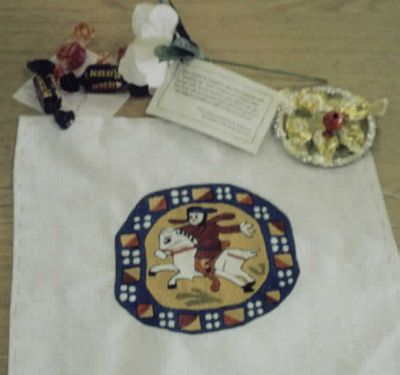Sorcha Valdimarsdottir
![]()
Welcome
News
Guild Info
Embroidery
Gallery
Calendar
 There are few pieces of embroidery that survive from the Byzantine age. One of these is a roundel of the Annunciation worked in silk on linen in satin stitch, stem stitch, and long and short stitch (Warren, Embroidery: A History, page 6). This particular piece is circular, with a border of hearts and flowers encircling the scene of the angel Gabriel visiting Mary to tell her that she will bear the son of God. This embroidered piece is similar to other woven pieces of the time called Coptic textiles. The Coptic pieces often follow the same pattern of a patterned border surrounding some sort of figure or scene.
There are few pieces of embroidery that survive from the Byzantine age. One of these is a roundel of the Annunciation worked in silk on linen in satin stitch, stem stitch, and long and short stitch (Warren, Embroidery: A History, page 6). This particular piece is circular, with a border of hearts and flowers encircling the scene of the angel Gabriel visiting Mary to tell her that she will bear the son of God. This embroidered piece is similar to other woven pieces of the time called Coptic textiles. The Coptic pieces often follow the same pattern of a patterned border surrounding some sort of figure or scene.
Although the embroidered piece depicts a biblical scene, in contrast to the mythological figures often depicted in woven Coptic textiles, the same design elements are present, suggesting that the same aesthetic principles were in place regardless of whether the piece was woven or embroidered. Another embroidered piece depicts the Nativity, worked in silk on linen in what appear to be split stitch (Rutschowscaya, Coptic Fabrics, page 133). Although this piece is intended to be a border, it follows the same pattern of a patterned border surrounding a scene. Split stitch was also used in other Byzantine embroideries to detail the faces of people (Johnstone, Byzantine Tradition in Church Embroidery, page 72).
Because of the stylistic similarities between woven and embroidered Coptic pieces, I felt that the best way to create a new embroidered piece was to look to the woven pieces. I chose a Coptic woven piece dating from the 7-8th centuries that I thought would translate well into embroidery (please see pages 5-6of the documentation). It is a simple figure of a cavalier, a man on horseback, with a patterned border, echoing the design of the Annunciation roundel.
I enlarged the photograph of the medallion and traced the outlined of the design with a black pen. I then taped the paper to my fabric, taped the fabric to a sunny window and traced the design onto the fabric with a fine point pen. Ideally, this piece would have been worked in silk thread on linen fabric, but as I hope to use this as a decoration for a tunic for my lord (who washes everything in hot water and dries it on high heat), I chose washable cotton fabric and colorfast cotton DMC embroidery floss. Once the design had been traced, I consulted my original photocopy to decide how to begin my embroidery.
Black lines were used in many places to make clear the lines of the design and I followed the lines of the original as much as possible. However, I did make some changes that I felt made the design clearer and more cohesive. I outlined the squares in the border in black instead of white, I outlined the edges of my border in black to make them more distinct, and I chose to make apparent what I thought was the rider's foot, which seemed to blend into the saddle.
I worked the piece in split stitch, as that was what I believed the Nativity piece had been worked in. Split stitch also creates a durable piece and I very much wanted this piece to stand up to the abuse of a man who is not easy on his clothes. I did use a hoop on this piece to maintain an even tension, as split stitch can sometimes distort the fabric as you fill in the design.
I chose my colors after looking at several other Coptic pieces (please see pages 8-9 of the documentation). The colors used in these other pieces are warm and rich—I tried to echo that feel in my own color choices. I used DMC colors 311(blue), 543 (flesh), 3857 (dark rust), 919 (bright pumpkin), 783 (gold), 731 (sage) , white, and black. After the piece was finished, I ironed it on a linen setting. The piece is roughly hemmed around the edges, as I have not yet decided what I am going to put the embroidery on. The tentative plane is to make another medallion and appliqué the embroidery onto a tunic.
Johnstone, Pauline. Byzantine Tradition in Church Embroidery. Chicago: Argonaut, Inc., 1967.
Rutschowscaya, Marie-Helene. Coptic Fabrics. Paris: Adam Biro, 1990.
Warner, Pamela. Embroidery: A History. London: B.T. two small roundels. An excellent resource!
(All copyright privledges remain with the author. Copyright 2002 Scorcha Valdimarsdottir)